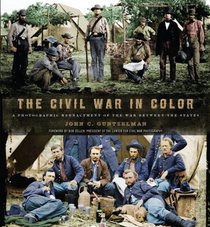This is really a fascinating collection of photographs. Many I have seen before, but many others were new to me. And I especially liked the fact the author included closer details of numerous photographs. As a Civil War living historian who is paid to lead battlefield tours, I have no problem seeing these original black and white photographs colorized. If anything, it brings the photos, and history, to life.
Some may criticize this volume for coloring original black and white images. Decades ago, studios began colorizing black and white movies, except for some specific movies, such as the opening scenes of "The Wizard of Oz" or "The Train," a World War II movie deliberately filmed in black and white. Colorization proved popular until some people in Hollywood claimed colorization ruined the "art of the movie." Everyone quickly lined up behind this "politically correct" attitude and movie colorization ceased.
I remember this as I had some stock in one company doing the colorization and lost some money. For some reason, Hollywood wasn't bothered by its 'art' being destroyed by the cutting of numerous scenes from movies later shown on TV. But then Hollywood is all about money and hypocrisy.
It was particularly interesting to read, in the book's introduction, that in the early 1850s Levi Hill, a New York artist, produced daguerreotypes, a silver-plated photograph, in natural colors. Other photographers who visited his studio confirmed this. Unfortunately, Hill kept his process secret until he could patent it, but took a long time to prefect the process. By the time he released details on the process, new photographic processes were in use and daguerreotypes were considered old fashioned.
When Hill died in 1865, his technique was forgotten. As a result, color photography was not perfected again until the 1950s. However, in 1984, a photography expert replicated Hill's technique and prove Hill's claim was valid.
The only problem with this book is the author, while an expert on photography, is not as well versed in Civil War history. He made numerous, little mistakes he could have avoided if only a valid Civil War historian reviewed the book before it was published. I'll only mention one of these. On one page he states the "Civil War lasted almost five years." I'm sure this would be a surprise to the people who lived back then, as the war began in April 1861 and ended in April 1865, or a total of four years.
Some may complain there are few images of Confederate forces. Once again, this is simply accurate history. The Union blockage of the South prevented southern photographers from obtaining the materials needed to produce photographs. This is easier to understand when you also know southern newspapers were reduced to printing their issues on the backs of wallpaper by mid-war.
Some may criticize this volume for coloring original black and white images. Decades ago, studios began colorizing black and white movies, except for some specific movies, such as the opening scenes of "The Wizard of Oz" or "The Train," a World War II movie deliberately filmed in black and white. Colorization proved popular until some people in Hollywood claimed colorization ruined the "art of the movie." Everyone quickly lined up behind this "politically correct" attitude and movie colorization ceased.
I remember this as I had some stock in one company doing the colorization and lost some money. For some reason, Hollywood wasn't bothered by its 'art' being destroyed by the cutting of numerous scenes from movies later shown on TV. But then Hollywood is all about money and hypocrisy.
It was particularly interesting to read, in the book's introduction, that in the early 1850s Levi Hill, a New York artist, produced daguerreotypes, a silver-plated photograph, in natural colors. Other photographers who visited his studio confirmed this. Unfortunately, Hill kept his process secret until he could patent it, but took a long time to prefect the process. By the time he released details on the process, new photographic processes were in use and daguerreotypes were considered old fashioned.
When Hill died in 1865, his technique was forgotten. As a result, color photography was not perfected again until the 1950s. However, in 1984, a photography expert replicated Hill's technique and prove Hill's claim was valid.
The only problem with this book is the author, while an expert on photography, is not as well versed in Civil War history. He made numerous, little mistakes he could have avoided if only a valid Civil War historian reviewed the book before it was published. I'll only mention one of these. On one page he states the "Civil War lasted almost five years." I'm sure this would be a surprise to the people who lived back then, as the war began in April 1861 and ended in April 1865, or a total of four years.
Some may complain there are few images of Confederate forces. Once again, this is simply accurate history. The Union blockage of the South prevented southern photographers from obtaining the materials needed to produce photographs. This is easier to understand when you also know southern newspapers were reduced to printing their issues on the backs of wallpaper by mid-war.




